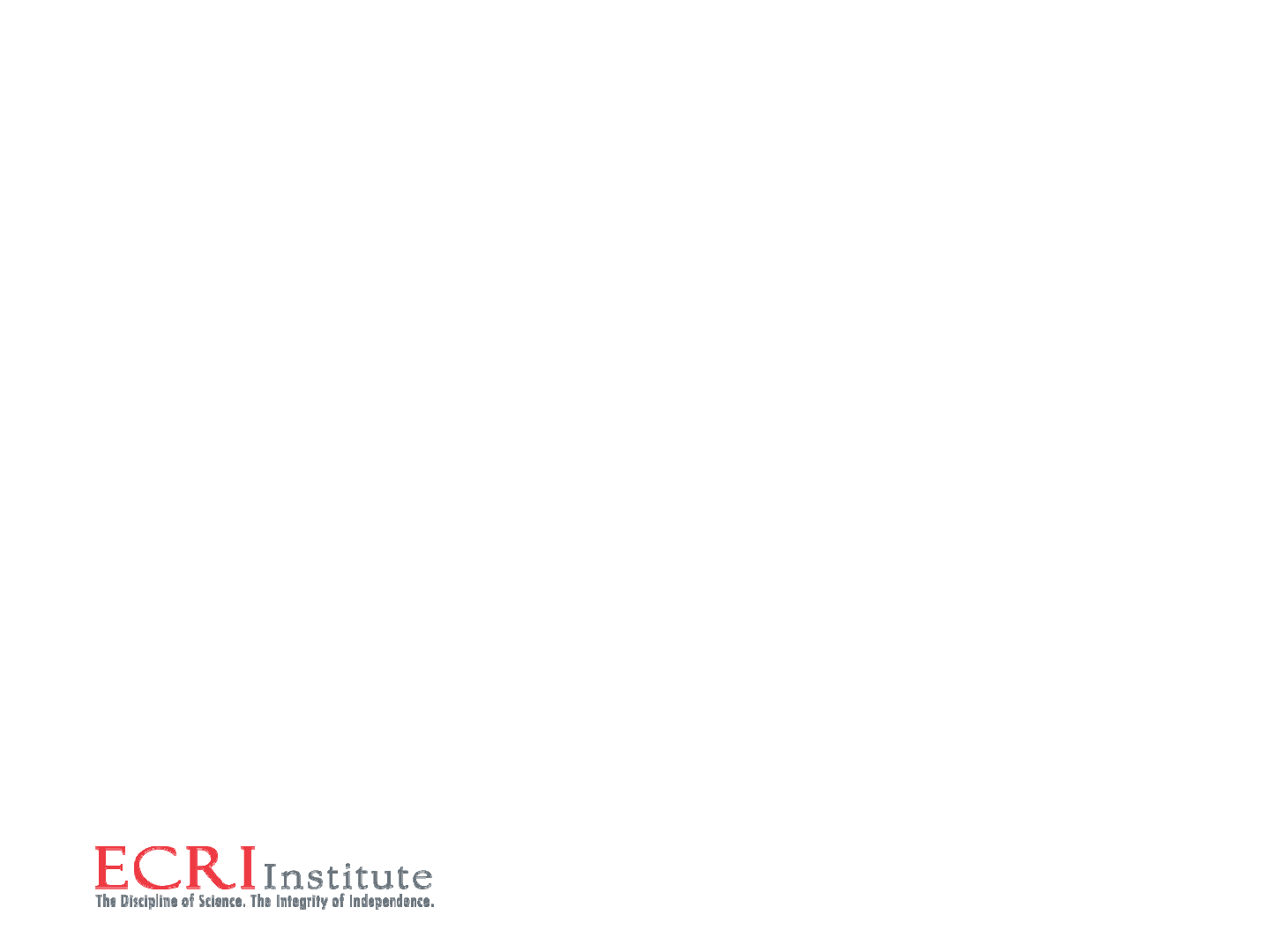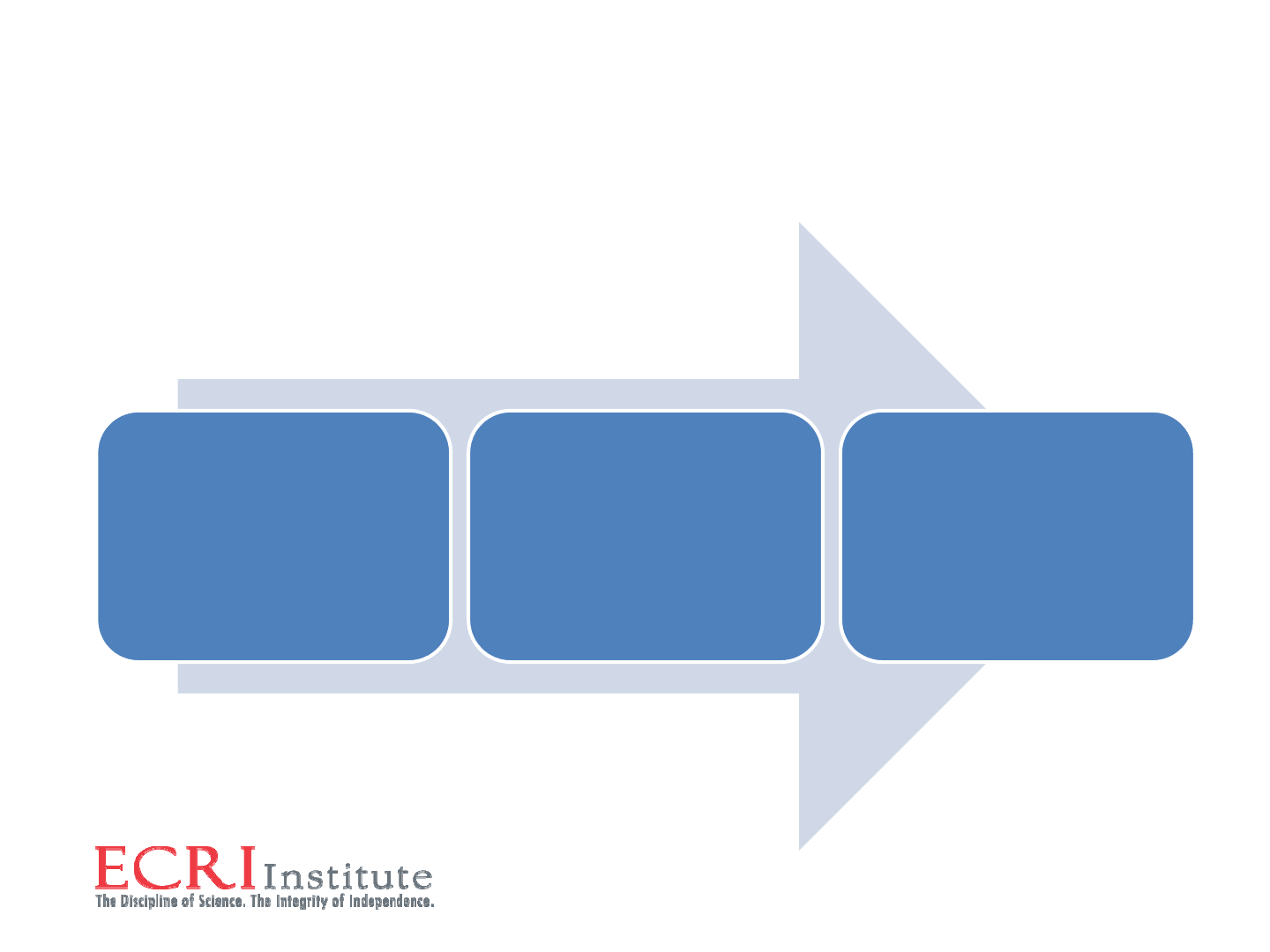
©2016 ECRI INSTITUTE
Effective
Management of
Complaints and
Grievances
Jennifer Comerford, MJ, OTR/L, CHC, HEM
Senior Risk Management Analyst
October 7, 2016

©2016 ECRI INSTITUTE
My Own Experiences
Provider
Manager
Family
member

©2016 ECRI INSTITUTE
True or False???
Complaints are valid by the fact of their existence

©2016 ECRI INSTITUTE
Clinical Framework
Continuumof
care
•Homecare
•Shortstay
•Long‐termcare
• Hospice
Individuals
served
• Clients
•Patients
• Residents
• Families
Nomenclature
• Complaints
• Grievances
• Issues
•Concerns
Common
themes
•Risk
• Opportunity

©2016 ECRI INSTITUTE
Regulatory Framework
Source:NJDCA

©2016 ECRI INSTITUTE
Learning Objectives
1. Distinguish between a complaint and a grievance
2. Describe risk management implications of complaints
3. Describe methods to capture and investigate complaints
4. Recall strategies for complaint resolution and response

©2016 ECRI INSTITUTE©2016 ECRI INSTITUTE
Learning Objective #1
Distinguish between a complaint and a grievance

©2016 ECRI INSTITUTE
True or False?
Complaints are smaller issues and grievances are more
significant

©2016 ECRI INSTITUTE
Distinguishing Between Complaints and
Grievances
Complaints
Minor issues
Quickly resolved
Handled by staff present
Grievances
■ Significant issues
■ Cannot be resolved
immediately
■ Allegations involving
patient care
Source:CMSSOM

©2016 ECRI INSTITUTE
Examples of Complaints and Grievances
Complaints
Cold food
Lost personal belongings
Environmental concerns
Grievances
■ Unmet patient care
expectations
■ Breach of confidentiality
■ Lack of informed consent
■ Premature discharge
■ Allegations of abuse,
neglect
Sources:CMSSOM;VuksonandTurvey

©2016 ECRI INSTITUTE
Failure to Respond to
Customer Service Issues
Dietaryerrors
Equipmentindisrepair
Environmentalconcerns
Lostpersonalitems
Complaints
Sources:AHRQ;Myers

©2016 ECRI INSTITUTE
Attention
todetail
Excellent
customer
service
TRUST

©2016 ECRI INSTITUTE©2016 ECRI INSTITUTE
Learning Objective #2
Describe risk management implications of complaints

©2016 ECRI INSTITUTE
True or False?
Long-term care loss rates are increasing by 5% annually
Source:AonRiskSolutions

©2016 ECRI INSTITUTE
Claims Trends: Long-Term Care
Severityis
increasingby
2%annually
Frequencyis
increasingby
3%annually
Lossrates
are
increasing
by5%
annually
Source:AonRiskSolutions

©2016 ECRI INSTITUTE
Forecasted 2016 Claims Activity
Lossrate:$2,150/bed
Frequency:0.99claims/100beds
Severity:$217,000/claim
Source:AonRiskSolutions

©2016 ECRI INSTITUTE
Common Complaints in Nursing Facilities
Issues surrounding discharge
Failure to answer requests for assistance
Lack of respect for residents
Quality-of-life issues
Problems with medication administration
Source:AdministrationonAging

©2016 ECRI INSTITUTE
Postacute Patients: Special Concerns
High
expectations
No“bankof
trust”
Clinical
complexity
Failureto
meet
expectations
Unresolved
complaints

©2016 ECRI INSTITUTE
Regulatory Requirements and
Accreditation Standards—Brief Survey
Centers for Medicare and Medicaid Services (CMS) for
long-term care facilities
CMS for home health agencies
Commission on Accreditation of Rehabilitation Facilities
(CARF)
The Joint Commission
State regulations
Sources:CARF;CMSHHA,LTC;
TheJointCommission

©2016 ECRI INSTITUTE
Organizational Policy and Procedure
Clearly defines “complaint” and “grievance”
Delineates procedures for investigation and response
Informs patients, residents, and families of their rights
Specifies timeframes for response
Provides information regarding resources for advocacy
Ensures multidisciplinary oversight
Sources:CARF;CMSHHA,LTC,SOM;
TheJointCommission

©2016 ECRI INSTITUTE
Dissatisfied Customers:
How Many Complain to the Service Provider?
Source:AHRQ

©2016 ECRI INSTITUTE
Dissatisfied Customers:
How Many Complain to Family and Friends?
Sources:AHRQ;LevinandHopkins

©2016 ECRI INSTITUTE
Complaints and Grievances in Healthcare
People underreport unhappiness with their healthcare
due to fear of:
■ Retaliation
■ Jeopardizing the quality of care
Source:NCAL

©2016 ECRI INSTITUTE
Emotional Harm Resulting from Disrespect
Respect has been defined as “the actions taken towards
others that protect, preserve, and enhance their dignity.”
Examples of emotional harms
Event types
■ Communication
■ Environment of care
■ Care after death
Source:Sokol‐Hessneretal.

©2016 ECRI INSTITUTE
Emotional Harm:
Implications for Aging Services
Theme of care after death
Impacts on other residents
Source:Sokol‐Hessneretal.

©2016 ECRI INSTITUTE©2016 ECRI INSTITUTE
Learning Objective #3
Describe methods to capture and investigate complaints

©2016 ECRI INSTITUTE
True or False?
Organizations can only address the complaints of which
they are aware

©2016 ECRI INSTITUTE
Complaint Capture
Proactive approach: actively solicit feedback
Identify
■ Patterns and opportunities
■ At-risk staff, and improve resident satisfaction

©2016 ECRI INSTITUTE
Case Study: Complaint Capture
Identified repositories of
patient concerns:
Letters
E-mails
Walk-ins
Telephone calls
Electronic health record
Clinical staff and managers
Patient satisfaction surveys
Centralized the process
for complaint capture
■ Single tracking system
Trained staff
Increased use of
complaint data
Source:LevinandHopkins

©2016 ECRI INSTITUTE
Strategies for Sustained Improvement in
Complaint Capture
Use of patient liaisons
Brochures in multiple languages
Visible telephone numbers for concerns
Asking patients if all of their needs are being met
Source:LevinandHopkins

©2016 ECRI INSTITUTE
It’s Free to Have an Open Door

©2016 ECRI INSTITUTE
Methods to Capture Complaints
Ask for feedback
Encourage candor
Ensure nonretaliation
Collaborate among staff
Designate a single repository

©2016 ECRI INSTITUTE
Preliminary Investigation
Becomeawareof
complaint
Initial
acknowledgment
Document
complaint
Begintogather
facts
Source:NCAL

©2016 ECRI INSTITUTE
Steps in a Grievance Investigation
Reviewmedical
records
Interview
patient
Interview
complainant
Interviewstaff
Research
applicable
authority
Identify
resolution
Sources:AHRQ;NCAL;Venn

©2016 ECRI INSTITUTE©2016 ECRI INSTITUTE
Learning Objective #4
Recall strategies for complaint resolution and response

©2016 ECRI INSTITUTE
True or False?
Many staff know immediately which situations or patients
will eventually end up in the CEO’s office
Source:AHRQ

©2016 ECRI INSTITUTE
Critical Themes of Complaint Resolution
Proactive
follow‐up
Respect
Nonretaliation
Addressing
theconcern

©2016 ECRI INSTITUTE
Staff Education and Training
Problem
Delivery
Source:NCAL

©2016 ECRI INSTITUTE
Good Listening Skills
Stopallactivityandmakeeyecontact
Sitdown
Maintainpositivebodylanguage
Restatetheconcern
Presentyourselfasapartner
Focusonmutualpointsofagreement
Projectconfidenceandtheabilitytoeffectachange
Donotavoidstressfulencounters
Offerasolutionandfollowthrough
Source:NCAL

©2016 ECRI INSTITUTE
Proactive Service Recovery
A process to “recover” dissatisfied patients
Demonstrate the ability to “get it right”
Restore trust and confidence
Source:AHRQ

©2016 ECRI INSTITUTE
“HEARD” for Service Recovery
H
• Hearthe
concern
E
•Empathize
withthe
individual
A
•Acknowledge
appreciation
•Apologizeas
warranted
R
•Respondto
concern
D
•Document
the
concern
Source:Haydenetal.

©2016 ECRI INSTITUTE
Empowering Staff to Respond
Straightforward direction
Clear protocols
Minimal bureaucratic roadblocks
Clear system of resources and lines of authority
Backup systems for addressing complex situations
Sources:AHRQ;Haydenetal.

©2016 ECRI INSTITUTE
Setting Realistic Expectations
Earntrust
Facilitate
understanding
Prevent
complaints
Sources:McMullin; Myers;NCAL

©2016 ECRI INSTITUTE
Setting Realistic Expectations: Examples
Examples:
■ Weight loss
■ Contracture
■ Fall precautions
■ Terminal prognosis
Source:Myers

©2016 ECRI INSTITUTE
Resolutions and Responses
for Postacute Patients
Nursing
Social
work

©2016 ECRI INSTITUTE
Written Response
Acknowledge risks of writing, and of not writing
Develop templates with legal counsel
Define a process
Respond thoughtfully and skillfully

©2016 ECRI INSTITUTE
Postresponse Analysis
Review findings
Discuss recommendations
Educate as appropriate
Failure mode and effects analysis, root-cause analysis

©2016 ECRI INSTITUTE
Tracking and Trending
Categorize data
Analyze in aggregate—powerful tool for quality
improvement
Share with:
■ Leadership
■ Multidisciplinary oversight committee
■ Staff
Sources:CARF;Venn

©2016 ECRI INSTITUTE
References
42 CFR § 482.13 (2006).
Administration on Aging (AOA). Long-term care ombudsman program. 2014 Oct 7. [cited 2016 Jul
22]. http://www.aoa.gov/AoA_programs/Elder_Rights/Ombudsman/index.aspx
Agency for Healthcare Research and Quality (AHRQ). Service recovery programs. 2015 Jul [cited
2016 Aug 4]. http://www.ahrq.gov/cahps/quality-improvement/improvement-guide/6-strategies-
for-improving/customer-service/strategy6p-service-recovery.html
Aon Risk Solutions. Long term care general liability and professional liability actuarial analysis.
2015 Nov [cited 2016 Jul 26]. http://www.aon.com/attachments/risk-
services/Aon_2015_Long_Term_Care_Liability_Actuarial_Analysis_full.pdf
Centers for Medicare and Medicaid Services (CMS).
Home health agencies (HHA). 2005 Aug 12 [cited 2016 Jul 22].
https://www.cms.gov/Regulations-and-Guidance/Legislation/CFCsAndCoPs/homehealth.html
Long term care facilities (LTC). 1989 Feb 2 [cited 2016 Jul 22].
https://www.cms.gov/Regulations-and-Guidance/Legislation/CFCsAndCoPs/LTC.html
State Operations Manual (SOM). Appendix A—survey protocol, regulations and
interpretive guidelines for hospitals. 2015 Nov 20 [cited 2016 Aug 4].
https://www.cms.gov/Regulations-and-
Guidance/Guidance/Manuals/downloads/som107ap_a_hospitals.pdf

©2016 ECRI INSTITUTE
References, continued
Commission on Accreditation of Rehabilitation Facilities (CARF). Continuing care retirement community
standards manual. Section 1.K.3-4. 2016 [cited 2016 Jul 22].
http://www.carf.org/WorkArea/DownloadAsset.aspx?id=23968
Hayden AC, Pichert JW, Fawcett J, Moore IN, Hickson GB. Best practices for basic and advanced skills in
health care service recovery: a case study of a re-admitted patient. Jt Comm J Qual Patient Saf 2010
Jul;36(7):310-8. PubMed: http://www.ncbi.nlm.nih.gov/pubmed/21226384
The Joint Commission. Standard RI.01.07.01. In: 2016 comprehensive accreditation manual for nursing
care centers. Oakbrook Terrace (IL): Joint Commission Resources; 2016.
Levin CM, Hopkins J. Creating a patient complaint capture and resolution process to incorporate best
practices for patient-centered representation. Jt Comm J Qual Patient Saf 2014 Nov;40(11):484-92.
PubMed: http://www.ncbi.nlm.nih.gov/pubmed/26111366
McMullin L. The hidden risks in patient complaints. Becker’s Hospital Review. 2015 May 5 [cited 2016
Jun 29]. http://www.beckershospitalreview.com/hospital-management-administration/the-hidden-risks-
in-patient-complaints.html
Myers B. Navigating the litigation quagmire. Provider (Long Term and Post-Acute Care). 2015 Sep [cited
2016 Jul 25]. http://www.providermagazine.com/archives/2015_Archives/Pages/0915/Navigating-
The-Litigation-Quagmire.aspx

©2016 ECRI INSTITUTE
References, continued
National Center for Assisted Living (NCAL). Turning complaints into compliments. 2005 [cited
2016 Jul 5].
https://www.ahcancal.org/ncal/operations/documents/complaints_compliments.pdf
New Jersey Division of Consumer Affairs (NJDCA). Patient bill of rights. 2015 Jul 7 [cited 2016
Jul 29]. http://www.njconsumeraffairs.gov/bme/Pages/Patient-Bill-of-Rights.aspx
Sokol-Hessner L, Folcarelli P, Sands KE. The practice of respect. NEJM Catalyst 2016 Jun 23
[cited 2016 Jul 25]. http://catalyst.nejm.org/the-practice-of-respect-improving-patient-
experience/
Venn L. Solving patient complaints while avoiding compliance snares. Health Care Compliance
Association national conference. 2010 [cited 2016 Jul 29]. http://www.hcca-
info.org/Portals/0/PDFs/Resources/Conference_Handouts/Compliance_Institute/2010/508ha
ndout.pdf
Vukson R, Turvey J. Grievance is NOT just a complaint. Presented at: American Society for
Healthcare Risk Management 2006 Annual Conference & Exhibition; 2006 Oct 31; San Diego
(CA).

©2016 ECRI INSTITUTE
Questions?
Please contact Jennifer Comerford, Senior Risk
Management Analyst at (610) 825-6000 x5165 or
jcomerfor[email protected]
Thank you
